Contents
Feature Article
News-in-brief
Editor's Notes
Thanks to your continued support, Electricity News has come to its 32nd issue. We have much to offer in this issue, which will be introduced by Cool, the female lead appearing in recent TV commercials of the Electrical and Mechanical Services Department (EMSD). The feature articles cover EMSD mobile apps and things to note about supplementary bonding conductors of fixed electrical installations. As to the news-in-brief column, it features the Construction Industry Caring Campaign – Fight against Novel Coronavirus, new edition of Guidance Notes for the Electrical Products (Safety) Regulation, responsibilities of competent persons, and safety tips for using R32 domestic air-conditioners. And what's more, the Electrical Safety Quiz column challenges you to puzzle the answers out, in the hope of adding fun to your reading and enhancing your knowledge about electrical safety.
Feature Article
Feature Article 1 - EMSD Mobile Apps
The EMSD launched mobile applications (apps) last December, which enable members of the public to access various electronic services and obtain latest updates from the EMSD anytime, anywhere with functions on their smart phones, bringing convenience to their life.
Feature Article
Feature Article 2 - Things to Note about Supplementary Bonding Conductors of Fixed Electrical Installations
According to the Code of Practice for the Electricity (Wiring) Regulations (hereinafter referred to as the CoP), supplementary bonding is a type of protective conductor. The four types of protective conductors as specified in Code 11C include:
- circuit protective conductors;
- main equipotential bonding conductors;
- supplementary bonding conductors; and
- earthing conductors.
Figure 11(1) of the CoP shows the application of the above four types of protective conductors and their interrelationships.
Before we go into the detailed requirements of supplementary bonding conductors, we should first learn about the main equipotential bonding conductors. Main equipotential bonding conductors are connected to the main earthing terminal chiefly through the main water pipes, gas installation pipes, other service pipes and ducting, risers and ducting of central heating and air-conditioning systems and exposed metallic parts of structural framework to create an equipotential zone. This is to ensure that zero electrical potential difference for the extraneous conductive parts in these equipotential zones is maintained at all times, so as to reduce the risk of electric shock. The main function of supplementary bonding conductors, which can be considered as extensions of the main equipotential bonding conductors, is to extend the equipotential zone.
According to Code 11F(a), within the zone formed by the main equipotential bonding, local supplementary bonding connections should be made to metal parts to maintain the equipotential zone, where those parts are:
- extraneous conductive parts;
- simultaneously accessible with exposed conductive parts or other extraneous conductive parts (Note 1); and
- not electrically connected to the main equipotential bonding by permanent and reliable metal-to-metal joints of negligible impedance.
Simply put, supplementary bonding connects extraneous conductive parts and their nearby exposed conductive parts or other extraneous conductive parts which are at a separation of not more than 2m in order to prevent a hazardous potential difference from occurring between them.
According to Code 11F(b), to determine whether conductive parts such as metallic bathroom accessories, metallic windows or metallic door handles are extraneous conductive parts, a measurement should be carried out to measure the insulation resistance between the conductive part and the main earthing terminal. For a typical single-phase supply system with a nominal supply voltage of 220V, if the measured resistance could be maintained at not less than 45 000 Ohm (Note 2) even under the worst conditions (e.g. high moisture), the metallic part could be considered as a non-extraneous conductive part. Therefore, registered electrical contractors and registered electrical workers may determine in accordance with the above-mentioned Code whether supplementary bonding is required for metallic bathroom accessories, metallic windows or metallic door handles.
News-in-brief
News-in-brief 1 - Review of the Code of Practice for the Electricity (Wiring) Regulations
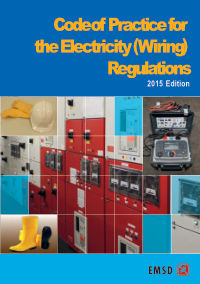 The EMSD published the first edition of the Code of Practice for the Electricity (Wiring) Regulations (hereinafter referred to as the CoP) in 1992 to provide the electrical trade with technical guidelines on how the requirements of the Electricity (Wiring) Regulations can be met. The EMSD reviews and revises the CoP regularly to ensure that its safety and technical requirements are up-to-date.
The EMSD published the first edition of the Code of Practice for the Electricity (Wiring) Regulations (hereinafter referred to as the CoP) in 1992 to provide the electrical trade with technical guidelines on how the requirements of the Electricity (Wiring) Regulations can be met. The EMSD reviews and revises the CoP regularly to ensure that its safety and technical requirements are up-to-date.
The EMSD has established a working group whose members include representatives from academic institutions, professional bodies, power companies, consultants' associations, trade contractors' associations, trade unions and relevant government departments to conduct a new round of revisions to the 2015 Edition of the CoP. The working group will discuss proposed revisions according to the latest international standards (including BS 7671:2018, which is equivalent to the 18th Edition of the Institution of Engineering and Technology Wiring Regulations) and feedback from the trade.
News-in-brief
News-in-brief 2 - Construction Industry Caring Campaign - Fight against Novel Coronavirus
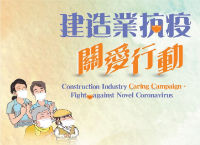 The "Construction Industry Caring Campaign – Fight against Novel Coronavirus" launched by Construction Industry Council has been extended the beneficiary coverage to registered electrical workers, registered lift workers, registered escalator workers and registered gas installers under the relevant ordinances enforced by this Department. For application details and a donation form of this Campaign, please visit the relevant website or contact the Construction Industry Council (Tel. 2100 9000 / Email: enquiry@cic.hk).
The "Construction Industry Caring Campaign – Fight against Novel Coronavirus" launched by Construction Industry Council has been extended the beneficiary coverage to registered electrical workers, registered lift workers, registered escalator workers and registered gas installers under the relevant ordinances enforced by this Department. For application details and a donation form of this Campaign, please visit the relevant website or contact the Construction Industry Council (Tel. 2100 9000 / Email: enquiry@cic.hk).
We appeal you all to proactively consider making donations to support the above-mentioned Campaign so that workers and their families affected by the epidemic could receive appropriate support.
News-in-brief
News-in-brief 3 - Guidance Notes for the Electrical Products (Safety) Regulation (2019 Edition)
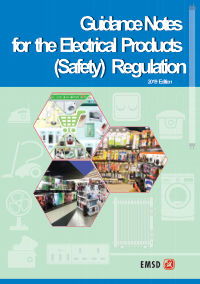 The Electrical Products (Safety) Regulation (the Regulation) regulates all electrical products which are designed for household use and supplied in Hong Kong. The EMSD has published guidance notes on the Regulation to facilitate suppliers of electrical products in understanding the detailed requirements of the Regulation. To keep pace with the times and keep abreast of the latest developments in technology, safety requirements and trade practices, the EMSD has published the 2019 Edition of the Guidance Notes for the Electrical Products (Safety) Regulation (the Notes).
The Electrical Products (Safety) Regulation (the Regulation) regulates all electrical products which are designed for household use and supplied in Hong Kong. The EMSD has published guidance notes on the Regulation to facilitate suppliers of electrical products in understanding the detailed requirements of the Regulation. To keep pace with the times and keep abreast of the latest developments in technology, safety requirements and trade practices, the EMSD has published the 2019 Edition of the Guidance Notes for the Electrical Products (Safety) Regulation (the Notes).
Review process
In order to broadly solicit and collect the views of the trade and members of the public, the EMSD conducted consultation in December 2018 to February 2019. Subsequently, a working group was set up in May 2019, whose members include representatives from trade associations, professional bodies, tertiary institutions, public utility companies, government departments and the public sector. After a number of discussions at the working group meetings, and having regard to the views received during the consultation, major revisions have been incorporated into the new edition of the Notes accordingly.
 Major revisions
Major revisions
- New chapter of "Quick Summary"
To provide a quick and easy reference for readers to grasp the important contents of the Notes, a "Quick Summary" chapter has been added to the new edition of the Notes to offer a simplified overview of the major requirements of the Regulation, such as giving a brief description of who may be considered as the supplier of an electrical product and how to check to ensure the availability of the certificate of safety compliance (CSC), providing samples of CSC for reference, and illustrating the safety requirements for plugs with graphics, etc. In addition, concise checklists have been added to the new chapter to facilitate suppliers in conducting a preliminary check on whether their electrical products comply with the requirements of the Regulation.

Samples of CSC Documents

Plugs of Electrical Products
- Improved layout design and addition of supplementary information
Supplementary information has been added to the Notes as appropriate to explain the requirements of the Regulation in a more lively and comprehensible manner, such as adding the icons of electrical products in the technical guidance so that readers can search for the requirements for relevant types of electrical products in the Notes, illustrating the requirements for the markings of electrical products with graphics, etc. Besides, the layout design of the new Notes has been improved for better presentation.

Sample of Product Markings
- Safety requirements for new electrical products
With technological advancement, the safety requirements for some new electrical products (such as LED products, socket-outlets with USB ports, etc.) have been added to the new Notes. What's more, the new Notes have also included the photobiological safety requirements for lighting equipment and related standards of USB port requirements for socket-outlets.
- Update of safety standards
The new Notes have updated the safety standards of electrical products after the review.

Safety Standards of Electrical Products
More about the Notes
The new Notes can be downloaded for free at the EMSD website or purchased from the Publications Sales Unit of the Information Services Department at Room 626, 6/F, North Point Government Offices, 333 Java Road, North Point.
News-in-brief
News-in-brief 4 - Responsibilities of Competent Persons
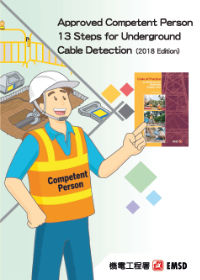 According to the Electricity Supply Lines (Protection) Regulation and the requirements of its code of practice, before commencement of works in the vicinity of an underground electricity cable (U/G cable), all reasonable steps should be taken to ascertain the existence of any such U/G cable within the proposed works site and its vicinity as shown in the cable plan from the electricity supplier. Prior to commencement of works, the working party shall obtain a cable plan from the electricity supplier. If the cable plan indicates the existence of any U/G cable within the proposed works site or within a specified distance from the works site, the working party shall appoint a competent person to carry out the cable detection work.
According to the Electricity Supply Lines (Protection) Regulation and the requirements of its code of practice, before commencement of works in the vicinity of an underground electricity cable (U/G cable), all reasonable steps should be taken to ascertain the existence of any such U/G cable within the proposed works site and its vicinity as shown in the cable plan from the electricity supplier. Prior to commencement of works, the working party shall obtain a cable plan from the electricity supplier. If the cable plan indicates the existence of any U/G cable within the proposed works site or within a specified distance from the works site, the working party shall appoint a competent person to carry out the cable detection work.
The appointed competent person shall refer to the cable plan from the electricity supplier and undertake an investigation to ascertain the existence of any U/G cable within the proposed works site and its vicinity, and determine its alignment and depth. He or she shall provide the working party with a written report of his or her findings from the investigation and give a briefing on it as required by the working party. The competent person shall undertake the investigation and supervise the excavation of trial holes in person, and shall not delegate the function and duty of the investigation to another person. Assistance from the electricity supplier shall be sought if difficulty is encountered in locating the U/G cables.
A competent person who undertakes an investigation to ascertain the existence, alignment and depth of U/G cables shall carry out the investigation in a manner that does not cause damage to, or impair the operation of, the U/G cables. If a competent person fails to comply with the above requirements, his or her approval as a competent person may be suspended.
News-in-brief
News-in-brief 5 - Safety Tips for Using R32 Domestic Air-conditioners
 Figure 1
Figure 1
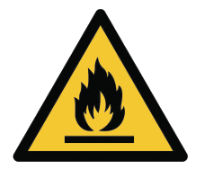 Figure 2
Figure 2
At present, several manufacturers in the market have launched domestic air-conditioners using R32 refrigerant (the chemical name of R32 is difluoromethane, which is mildly flammable). When buying air-conditioners, we can find out the type of refrigerant used on the energy label (see Figure 1).
We should pay attention to the following safety tips during the installation and maintenance of R32 domestic air-conditioners:
- The body of the air-conditioner should bear the "flame" label (see Figure 2);
- The installation, inspection or maintenance of such products should be carried out by suppliers or experienced personnel who have completed relevant training;
- The requirements on minimum room area and minimum installation height as specified by the manufacturer must be complied with;
- The place of installation should not be close to a fire source or an electrical heating device;
- Do not weld or cut pipework that contains R32 refrigerant;
- As R32 refrigerant is heavier than air, appropriate leakage detectors and refrigerant recovery equipment should be used; the recovered R32 refrigerant shall be handled by a licensed contractor and shall not be disposed of illegally; and
- Do not store or transport R32 refrigerant illegally as it belongs to Class 2 dangerous goods under the Dangerous Goods Ordinance.
Electrical Safety Quiz
Q1
|
According to Code 11C of the Code of Practice for the Electricity (Wiring) Regulations, which of the following is a type of protective conductor?
|
- Main equipotential bonding conductor
- Supplementary bonding conductor
- Earthing conductor
- All of the above
|
Q2
|
The working group on the review of the Code of Practice for the Electricity (Wiring) Regulations comprises members from
|
- Government departments and power companies
- Trade unions, trade contractors' associations and consultants' associations
- Academic institutions and professional bodies
- All of the above
|
Q3
|
According to the Guidance Notes for the Electrical Products (Safety) Regulation (2019 Edition), which of the following is included in the chapter of "Quick Summary"?
|
- Persons who may be considered as the supplier of an electrical product
- Safety requirements for plugs
- How to ensure the availability of CSC of an electrical product
- All of the above
|
Q4
|
Which of the following is the duty of a competent person when carrying out the cable detection work?
|
- Undertake the investigation and supervise the excavation of trial holes in person
- Provide a written report of his or her findings from the investigation
- Give a briefing on the written report as required by the working party
- All of the above
|
Q5
|
Who should carry out the installation, inspection or maintenance of R32 domestic air-conditioners?
|
- Any person
- Personnel who have yet to complete relevant training
- Porters
- Suppliers or experienced personnel who have completed relevant training
|
Q6
|
Which of the following should we pay attention to during the installation of R32 domestic air-conditioners?
|
- The place of installation should not be close to a fire source or an electrical heating device
- The requirements on minimum room area and minimum installation height as specified by the manufacturer must be complied with
- Do not weld or cut pipework that contains R32 refrigerant
- All of the above
|
Readers' Feedback and Update
We look forward to receiving your valuable feedback for continuous improvement so that the contents of Electricity News and the services of the EMSD can better meet your needs. Please complete the form and return it to the Electricity Legislation Division of the EMSD by post, fax or e-mail (contact details at the bottom of this page) on or before 21 July 2020. Thank you.
Contact Information
Address: Electricity Legislation Division, EMSD, 3 Kai Shing Street, Kowloon, Hong Kong
Tel: 1823
Fax: 2895 4929
Email: info@emsd.gov.hk
Information for the Electrical Trade
 [PDF format (6.65MB)]
[PDF format (6.65MB)]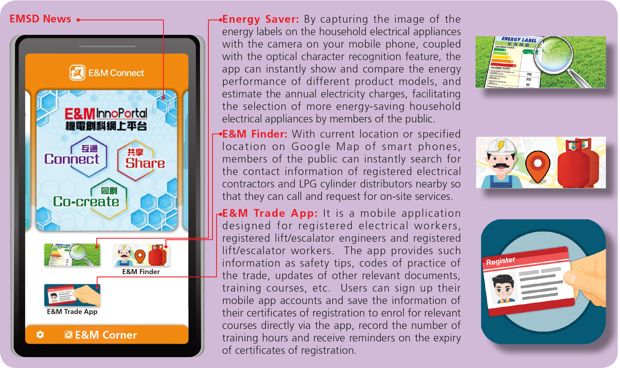


 The EMSD published the first edition of the Code of Practice for the Electricity (Wiring) Regulations (hereinafter referred to as the CoP) in 1992 to provide the electrical trade with technical guidelines on how the requirements of the Electricity (Wiring) Regulations can be met. The EMSD reviews and revises the CoP regularly to ensure that its safety and technical requirements are up-to-date.
The EMSD published the first edition of the Code of Practice for the Electricity (Wiring) Regulations (hereinafter referred to as the CoP) in 1992 to provide the electrical trade with technical guidelines on how the requirements of the Electricity (Wiring) Regulations can be met. The EMSD reviews and revises the CoP regularly to ensure that its safety and technical requirements are up-to-date. The "Construction Industry Caring Campaign – Fight against Novel Coronavirus" launched by Construction Industry Council has been extended the beneficiary coverage to registered electrical workers, registered lift workers, registered escalator workers and registered gas installers under the relevant ordinances enforced by this Department. For application details and a donation form of this Campaign,
The "Construction Industry Caring Campaign – Fight against Novel Coronavirus" launched by Construction Industry Council has been extended the beneficiary coverage to registered electrical workers, registered lift workers, registered escalator workers and registered gas installers under the relevant ordinances enforced by this Department. For application details and a donation form of this Campaign,  The Electrical Products (Safety) Regulation (the Regulation) regulates all electrical products which are designed for household use and supplied in Hong Kong. The EMSD has published guidance notes on the Regulation to facilitate suppliers of electrical products in understanding the detailed requirements of the Regulation. To keep pace with the times and keep abreast of the latest developments in technology, safety requirements and trade practices, the EMSD has published the 2019 Edition of the Guidance Notes for the Electrical Products (Safety) Regulation (the Notes).
The Electrical Products (Safety) Regulation (the Regulation) regulates all electrical products which are designed for household use and supplied in Hong Kong. The EMSD has published guidance notes on the Regulation to facilitate suppliers of electrical products in understanding the detailed requirements of the Regulation. To keep pace with the times and keep abreast of the latest developments in technology, safety requirements and trade practices, the EMSD has published the 2019 Edition of the Guidance Notes for the Electrical Products (Safety) Regulation (the Notes). Major revisions
Major revisions



 According to the Electricity Supply Lines (Protection) Regulation and the requirements of its code of practice, before commencement of works in the vicinity of an underground electricity cable (U/G cable), all reasonable steps should be taken to ascertain the existence of any such U/G cable within the proposed works site and its vicinity as shown in the cable plan from the electricity supplier. Prior to commencement of works, the working party shall obtain a cable plan from the electricity supplier. If the cable plan indicates the existence of any U/G cable within the proposed works site or within a specified distance from the works site, the working party shall appoint a competent person to carry out the cable detection work.
According to the Electricity Supply Lines (Protection) Regulation and the requirements of its code of practice, before commencement of works in the vicinity of an underground electricity cable (U/G cable), all reasonable steps should be taken to ascertain the existence of any such U/G cable within the proposed works site and its vicinity as shown in the cable plan from the electricity supplier. Prior to commencement of works, the working party shall obtain a cable plan from the electricity supplier. If the cable plan indicates the existence of any U/G cable within the proposed works site or within a specified distance from the works site, the working party shall appoint a competent person to carry out the cable detection work. Figure 1
Figure 1 Figure 2
Figure 2